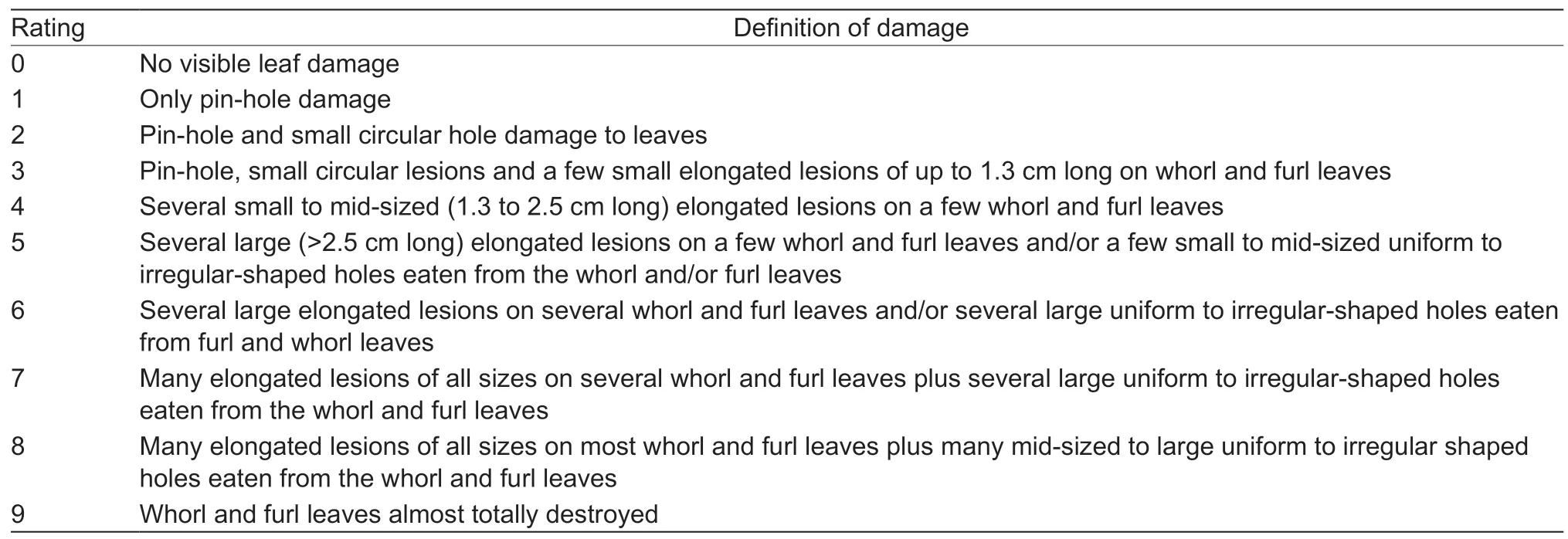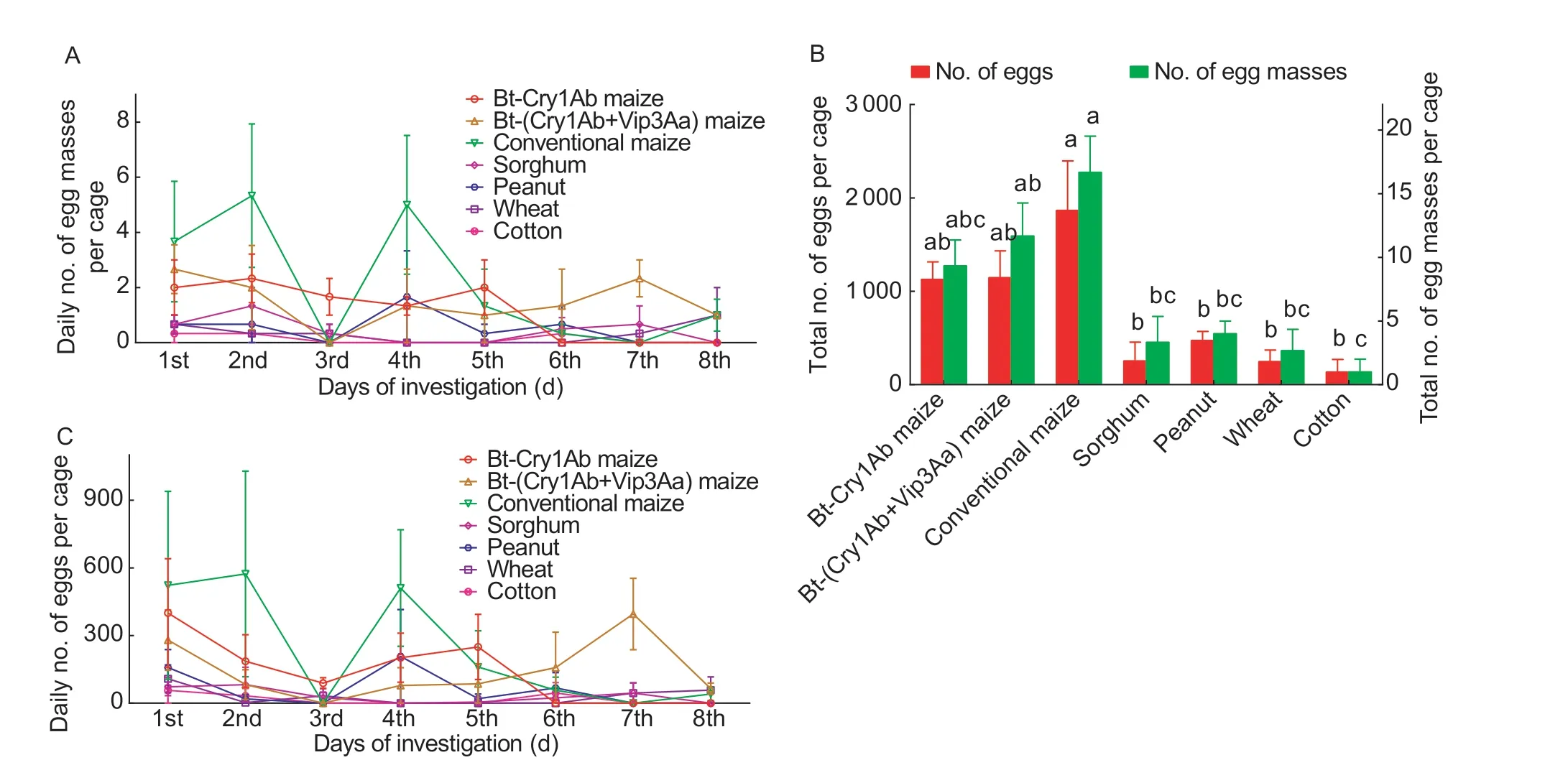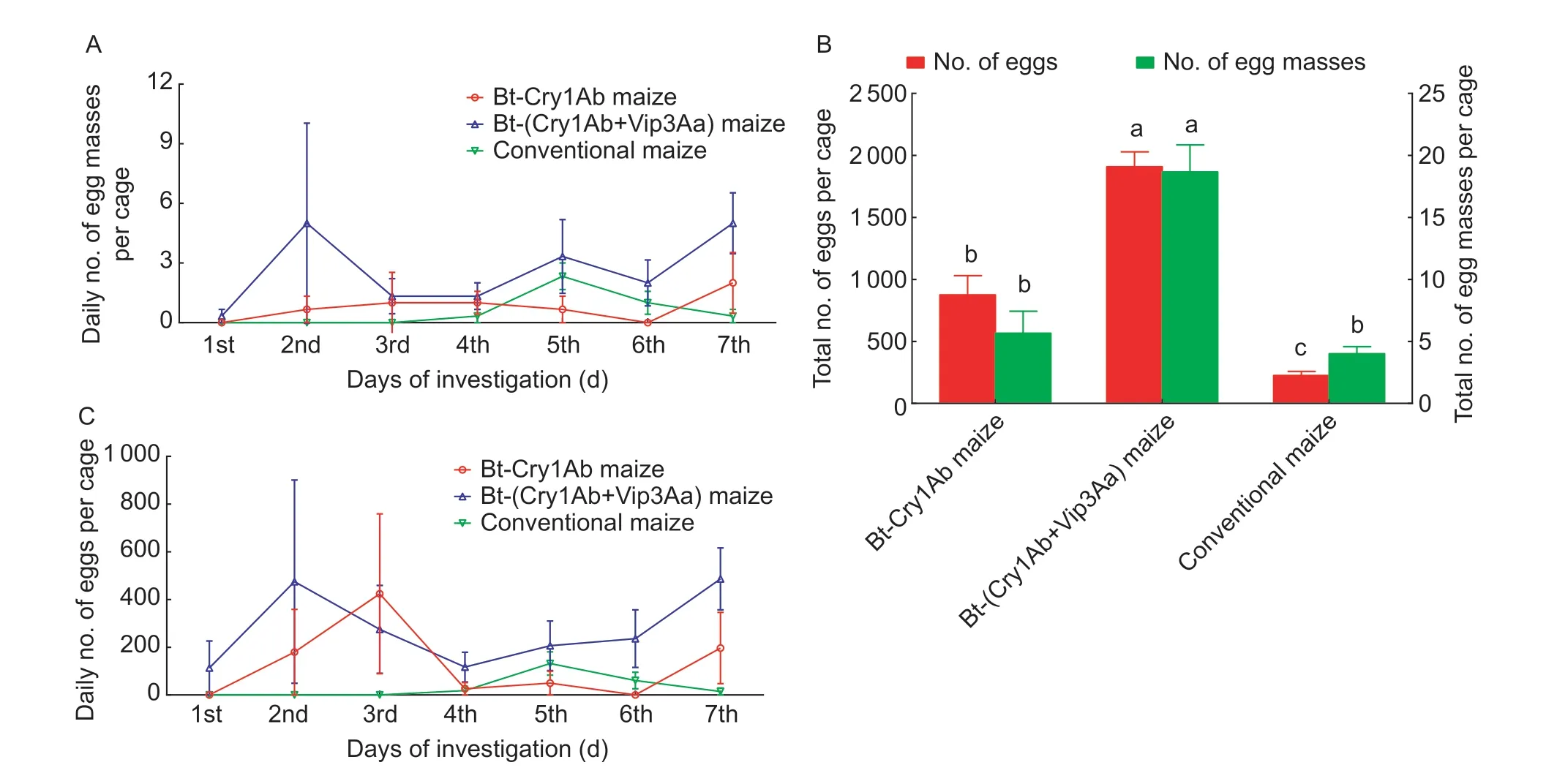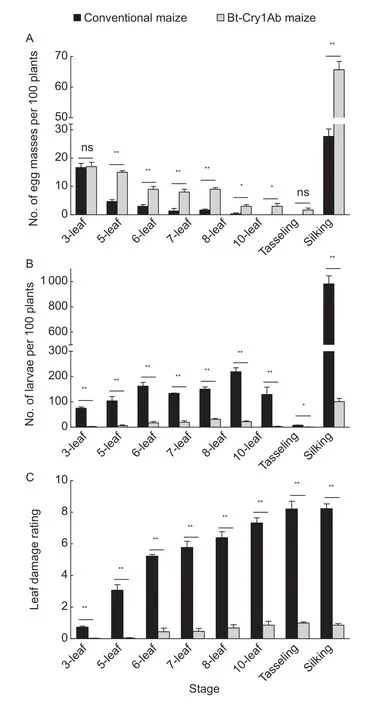Ovipositional responses of Spodoptera frugiperda on host plants provide a basis for using Bt-transgenic maize as trap crop in China
2021-02-25HELimeiZHAOShengyuanGAOXiwuWUKongming
HE Li-mei ,ZHAO Sheng-yuan ,GAO Xi-wu ,WU Kong-ming
1 State Key Laboratory for Biology of Plant Diseases and Insect Pests,Institute of Plant Protection,Chinese Academy of Agricultural Sciences,Beijing 100193,P.R.China
2 College of Plant Protection,China Agricultural University,Beijing 100193,P.R.China
Abstract Spodoptera frugiperda,the pest fall armyworm (FAW),is widespread in more than 100 countries.To date,planting insectresistant transgenic crops is one of the main control methods in its native countries.In this study we evaluated Bt-transgenic maize (Bt maize) and non-transgenic (conventional) maize and six other host plants in greenhouse pot experiments and field trials for oviposition preference by the Chinese populations of FAW.In laboratory trials,female moths preferred to oviposit on maize with no significant preference between conventional and Bt maize.However,after conventional and transgenic maize were exposed to FAW larvae and damaged,oviposition was significantly higher on transgenic maize than on the conventional one.Field trials showed that for plants less damaged at an early stage (seedling stage),oviposition of FAW on transgenic and conventional maize was significantly higher than that on wheat,sorghum,foxtail millet,peanut and soybean while showing no significant difference between transgenic or conventional maize.FAW adults mainly laid eggs on Bt maize,while the larval density and leaf damage rating or percentage of damaged plants were significantly lower than on conventional maize.Larval density and its damage on conventional maize were significantly higher than that on Bt maize and the other five hosts.Thus,maize is a highly preferred and suitable host for S.frugiperda feeding and ovipositing,and Bt maize can be used as trap crop to protect other crops.
Keywords:fall armyworm,oviposition behavior,trap crop,Bt maize
1.lntroduction
Native to tropical and subtropical America,the fall armyworm(FAW),Spodopterafrugiperda(J.E.Smith) (Lepidoptera:Noctuidae),is a relatively new invasive agricultural pest in China that quickly became widespread since its first sighting in December 2018 (Smith and Abbott 1797; Luginbill 1928; Sparks 1979; Johnson 1987; Jianget al.2019; Sunet al.2021).As a typical polyphagous pest,S.frugiperdais highly adaptable to a range of different host plants.Its larvae feed on more than 350 different host plants belonging to 76 plant families,including Poaceae,Asteraceae and Fabaceae (Montezanoet al.2018).Its polyphagy is one of the main reasons for the continuous damage and rampant populations of FAW in the agroforestry ecosystem.Previous studies have shown that adults of some insects can vary in oviposition preference depending upon the varietal characteristics,age and size,leaf-feeding damage,reproductive state and nutrient availability of the plants(Latheef and Irwin 1979; Thompson 1988).In general,adults of phytophagous insects prefer to oviposit on species of host plants that are nutrient-rich and suitable for larval growth (Berdegue and Trumble 1996).
Planting a trap crop that is much attractive to the pest can help the main crop from damage.For example,interplanting alfalfa strips in cotton fields significantly loweredLygushesperus(Knight) population levels and eliminated the need for insecticide use on this crop in the United States (Sternet al.1964,1969; Godfrey and Leigh 1994).In China,the planting of transgenic cotton expressing theBacillusthuringiensis(Bt) Cry toxins (Bt cotton) as a trap crop not only controlledHelicoverpaarmigera(Hübner),but also reduced its presence on other host crops such as wheat and maize (Wuet al.2008).Niboucheet al.(2012,2019) reported thatErianthusarundinaceus((Retzius)Jeswiet) is a trap crop for the sugarcane stem borerChilo sacchariphagus(Bojer).In addition,mungbean (Vigna radiatusL.) is a trap crop ofApolyguslucorum(Meyer-Dur.) to protect Bt-cotton (Luet al.2009),and velvetleaf(AbutilontheophrastiMedicus) can be used to trapBemisia tabaci(Gennadius) andSyleptaderogata(Fabricius) (Linet al.2015).Considering these preceding examples,trap cropping is worth to be explored as a management option for FAW in China.
Since 1996,the planting of Bt cotton has reduced damage from numerous serious insect pests (Chitkowskiet al.2003;Olsenet al.2005; Wanet al.2005; Wu and Guo 2005;Sivasupramaniamet al.2008; Wuet al.2008; Tindallet al.2009).It is also the main method to control and manage FAW on the American continent (Buntin 2008; Siebertet al.2008a,b; Hardkeet al.2011).Although resistance in FAW to Cry1Ab,Cry1Ac,Cry1Fa and Cry1F toxin fromB.thuringiensishas been reported (Blancoet al.2010;Ríos-Díezet al.2012; Fariaset al.2014; Chandrasenaet al.2018),the population in China has not developed significant resistance to toxic proteins ofB.thuringiensis,such as Cry1Ab,Cry1Ac,Cry1F,Cry2Ab and Vip3A (Li G Pet al.2019).Moreover,a laboratory bioassay indicated that Chinese domestic Bt-Cry1Ab and Bt-(Cry1Ab+Vip3Aa)maize has high control efficacy againstS.frugiperdain Yunnan,with the mortality rate of first instar larvae that had fed on Bt-Cry1Ab being 59.23–65.41% and 100% on Bt-(Cry1Ab+Vip3Aa) maize,respectively (Zhang and Wu 2019).
At least seven host plants ofS.frugiperdaare global agricultural crops:in China,FAW larvae have been recorded in fields of maize (Zeamays),wheat (Triticumaestivum),sorghum (Sorghumbicolor),soybean (Glycinemax),peanut(Arachishypogaea),cotton (Gossypiumspp.) and foxtail millet (Setariaitalica) (Montezanoet al.2018; Jianget al.2019).Here,we systematically assessed the oviposition preference ofS.frugiperdaon transgenic Bt-Cry1Ab,Bt-(Cry1Ab+Vip3Aa) and conventional non-transgenic maize and six other host plants in the laboratory and field.Our findings further showed that maize was highly preferred for ovipositing by FAW.Thus,commercial cultivation of Bt-transgenic maize (Bt maize) as a trap crop can potentially be used to control this pest.Bt maize may also be used to protect other crops and improve the control and management ofS.frugiperdain Asia.
2.Materials and methods
2.1.Laboratory pot trials
Laboratory trials were carried out at the Xinxiang Experiment Station of the Chinese Academy of Agricultural Sciences(CAAS; 35°18´13.71´´N,113°55´15.05´´E) in Henan Province,China.FAW individuals were field-collected in early 2019 in Dehong Autonomous Prefecture (Yunnan) and reared for 10 generations in the laboratory.Insects were kept at (25±1)°C,(75±5)% RH,and 16 h L:8 h D.Larvae were fed a soybean flour and wheat bran-based diet (Greeneet al.1976),and 1st to 6th instar FAW larvae were reared in 22 cm×15 cm×8 cm plastic boxes.Once larvae were fully developed,they were transferred to plastic trays with vermiculite for pupation.On the 5th day after pupation,male and female pupae were separated based on the method of Zhaoet al.(2011).
For experimental purposes,adults were exposed to seven different hosts:Bt-Cry1Ab maize (10 plants per pot,C0030.3.5-Nonghua 106,single hybrids,Beijing Dabei Agricultural Biotechnology Co.,Ltd.,Beijing,China),Bt-(Cry1Ab+Vip3Aa) maize (10 plants per pot,DBN3601-Nonghua 106,single hybrids,Beijing Dabei Agricultural Biotechnology Co.,Ltd.,Beijing,China),conventional maize(10 plants per pot,Nonghua 106,single hybrids,Beijing Dabei Agricultural Biotechnology Co.,Ltd.,Beijing,China),sorghum (12 plants per pot,Jinza 26),peanut (five plants per pot,Xiaobaisha),wheat (20 plants per pot,Xinong 529),and cotton (eight plants per pot,Zhongmiansuo 49).All plants were planted in 500-mL plastic cups containing a 60:35:5 mixture by mass of field soil (from the experimental field of the Xinxiang Experiment Station of the CAAS),organic cultivation soil (Huai’an Hui Sheng Horticulture Development Co.,Ltd.,Huai’an,Jiangsu,China) and vermiculite (1–3 mm,Lingshou Xuyang Mining Co.,Ltd.,Shijiazhuang,Hebei,China).All plants were grown in a greenhouse at (28±1)°C,with (80±5)% RH and 16 h L:8 h D.
Oviposition preference of FAW was tested on seedlings(20 cm tall; 4-leaf maize,4-leaf sorghum,5-leaf peanut,3-leaf wheat and 5-leaf cotton plants) in 50 cm×50 cm×50 cm cages (200-mesh nylon,seven species of plants and one pot for each plant per cage) and kept at (25±1)°C and (75±5)% RH,then 10 pairs of newly emerged adults(♀:♂=1:1) were transferred to the cage.FAW adults were fed daily with 5% (v/v) acacia honey water (acacia honey,Baihua brand,Beijing Baihua Bee Co.,Ltd.,Beijing,China).Daily,we counted the egg masses on seedlings (leaves and/or stems) of each plant,and then collected the egg masses in a separate 12 cm×17 cm zip-lock bag.After 3 days,we counted the larvae and unhatched eggs,and summed them to calculate the number of eggs.All plants were replaced every day with fresh ones until 8 days after oviposition.The test was repeated three times.
Oviposition preference of FAW was also tested on conventional and two Bt maize plants:newly hatched larvae were collected,transferred to seedlings of Bt-Cry1Ab maize,Bt-(Cry1Ab+Vip3Aa) maize and conventional maize (35 cm tall; plants were at the 4-to 5-leaf stage; three larvae per seedling).Five pairs of newly emerged adults (♀:♂=1:1)were put in the cage described above and fed daily with 5%(v/v) acacia honey water.Two days later,maize seedlings that had been damaged by FAW larvae were placed in the cage with adults (three lines of maize and one pot for each maize line per cage).FAW larvae remained on the plants for the duration of the experiment.A preliminary bioassay confirmed that FAW 1st instar larvae fed on and damaged Bt-Cry1Ab maize and Bt-(Cry1Ab+Vip3Aa) maize seedlings,although their survival rate on Bt-Cry1Ab maize was 34.59–40.77% and 0% on Bt-(Cry1Ab+Vip3Aa) maize(Zhang and Wu 2019).We counted the egg masses,then collected the egg masses from the leaves or stems of each plant and scattered them into individual egg with a brush.We then counted the eggs on each plant daily until 7 days after oviposition.On the last day of the experiment,the damage caused by FAW on all leaves on each plant was visually rated as shown in Table 1 (Davis and Williams 1994;Williamset al.2006).The test was repeated three times.
2.2.Field plot trials
For field trials at the experiment station of the Plant Protection Institute of Chinese Academy of Agricultural Sciences (CAAS; 22°41´13´´N,101°53´22´´E) in Shuicheng Village,Pu’er City,Yunnan Province,we used a single factor experimental design with a totally randomized block.All crops were planted manually,and the plant spacing and row spacing were,respectively,28 and 60 cm for maize and sorghum,4–6 and 20 cm for wheat and foxtail millet,6 and 35 cm for soybean,15 and 25 cm for peanut.Single-hybrid maize varieties were used in field trials.
Oviposition preference of FAW was tested on Bt and conventional maize (with three repetitions for each plant;total:six plots,each 30 m2):Bt-Cry1Ab maize (C0030.3.5-Nonghua 106,Beijing Dabei Agricultural Biotechnology Co.,Ltd.,Beijing,China) and conventional maize (Nonghua 106,Beijing Dabei Agricultural Biotechnology,China).All plants were sown on June 2,2019,and urea (20 kg 667 m–2,N content ≥46.4%,Yunnan Yuntianhua Co.,Ltd.,Kunming,China) and compound fertilizer (15 kg 667 m–2,CNP content ≥45%,Stanley Chemical Fertilizer Co.,Ltd.,Linshu,Shandong,China) were applied as a top dressing.On June 15,June 19,June 21,June 23,June 26,July 7,July 18 and July 28 (i.e.,13,17,19,21,24,35,46 and 56 days after sowing when maize plants were at the 3-leaf,5-leaf,6-leaf,7-leaf,8-leaf,10-leaf,tasseling and silking stages,respectively),the FAW egg masses on each plant were counted.We used a five-spot sampling method and sampled 20 plants at random from each location (Linet al.2015; Sunet al.2019).Leaf damage caused by FAW on maize was visually rated (Table 1).
Oviposition preference of FAW females also was tested on different host plants.Seven hosts were used,with three repetitions for each host (total:21 plots,each 30 m2).The seven tested hosts were Bt-(Cry1Ab+Vip3Aa)maize (DBN3601-Nonghua 106),conventional maize(Nonghua 106),sorghum (provided by local farmer),peanut(provided by local farmer),wheat (Chuanmai 1131),soybean(Zhonghuang 37) and foxtail millet (Langu 3).All plants were sown on October 3,2019,and urea (20 kg 667 m–2,N content≥46.4%,Yunnan Yuntianhua Co.,Ltd.,Kunming,China) and compound fertilizer (15 kg 667 m–2,CNP content ≥45%,Stanley Chemical Fertilizer Co.,Ltd.,Linshu,Shandong,China) were applied as a top dressing.On October 20,November 3,November 22,December 5 and December 20(i.e.,17,31,50,63 and 78 days after sowing),we counted the FAW egg masses and larvae on undamaged plants and the damaged plants by FAW,and the survey data were summarized and sorted by month.In October,November and December,plants were at seedling,vegetative growth and reproductive growth stages,respectively.We used a five-spot sampling method and sampled 20 plants randomly from each location (Linet al.2015; Sunet al.2019).Plants were examined for damage by FAW,counted and rated according to signs and symptoms of FAW damage (FAO and CABI 2019).Any plant with a translucent window hole,ragged edges or holes in its growth point,leaf,stem or fruit was recorded as damaged.
2.3.Statistical analysis
Differences in the number of eggs or egg masses,larval number,leaf damage rating and percentage of damaged plants for the different hosts were analyzed using a oneway analysis of variance (ANOVA),with proportional data first arcsine square-root-transformed to meet assumptions of normality and heteroscedasticity.Tukey’s honestly significant difference (HSD) test was used as a post hoc test.Student’st-test was used to test for significant differences in number of egg masses,larval number and leaf damage rating between conventional and Bt-Cry1Ab maize from the plot trial.All data were analyzed using SPSS version 20(IBM,Armonk,NY,USA).Data in the text and figure are mean±SE.
3.Results
3.1.Oviposition preference of S.frugiperda on different hosts
Adults oviposited eggs on all seven host plants,but the host species affected oviposition behavior (Fig.1).There weresignificant differences in the total number of egg masses(F6,14=6.037,P=0.003,Fig.1-C) and eggs (F6,14=8.278,P=0.001,Fig.1-C) among the seven hosts.Overall,S.frugiperdafemales laid the most egg masses (16.67±2.85 per cage) and eggs (1865.67±529.84 per cage) on conventional maize plants,followed by Bt-(Cry1Ab+Vip3Aa)maize plants and Bt-Cry1Ab maize plants,which are higher than on peanut,sorghum,wheat and cotton.However,there was no significant difference in the number of egg masses and eggs among the two Bt maize hosts and the conventional maize.Notably,most of the eggs were located on the abaxial side of leaves; some were distributed on the adaxial side of leaves and on stems.

Table 1 Leaf damage ratings

Fig.1 Daily number of egg masses (A),eggs (C) and total number of egg masses and eggs (B) laid by Spodoptera frugiperda on seven hosts.Bar is SE (n=3).Different lowercase letters indicate a significant difference in the number of eggs or egg masses among the hosts at P<0.05 level in a one-way ANOVA followed by Tukey’s HSD.
3.2.Ovipositional response of S.frugiperda among three maize genotypes
The damage level of leaves was significantly greater on conventional maize than on Bt maize (F2,87=1 376.538,P<0.001):0.21±0.01 on Bt-(Cry1Ab+Vip3Aa) maize plants,0.87±0.04 on Bt-Cry1Ab maize plants and 2.48±0.04 on conventional maize plants.That is,Bt-(Cry1Ab+Vip3Aa) and Bt-Cry1Ab maize plants were less damaged byS.frugiperdalarvae,while conventional maize plants were seriously damaged byS.frugiperdalarvae.
Adults oviposited eggs on all damaged maize plants(Fig.2); however,there was a significant difference in the total number of egg masses (F2,6=23.527,P=0.001,Fig.2-C) and eggs (F2,6=54.942,P<0.001,Fig.2-C) ofS.frugiperdaamong the larvae-damaged conventional maize,Bt-Cry1Ab maize and Bt-(Cry1Ab+Vip3Aa) maize plants.Overall,S.frugiperdafemales laid the most egg masses (18.67±2.18 per cage) and eggs (1 909.00±119.96 per cage) on less-damaged Bt-(Cry1Ab+Vip3Aa) maize plants,while laying fewer egg masses (4.00±0.58 per cage)and eggs (225.67±32.09 per cage) on seriously damaged conventional maize plants.
3.3.Oviposition preference of S.frugiperda for Bt and conventional maize in the field
In the field,S.frugiperdaadults laid a similar number of egg masses on Bt-Cry1Ab and conventional maize when plants were at the 3-leaf stage (t=0.158,df=4,P=0.882,Fig.3-A).However,females in general laid more egg masses on Bt-Cry1Ab than on conventional maize plants:the difference was significant for the number ofS.frugiperdaegg masses when maize was at the 5-leaf (t=11.717,df=4,P<0.001,Fig.3-A),6-leaf (t=5.196,df=4,P=0.007,Fig.3-A),7-leaf (t=5.000,df=4,P=0.007,Fig.3-A),8-leaf (t=11.000,df=4,P<0.001,Fig.3-A),10-leaf (t=4.000,df=4,P=0.016,Fig.3-A) and tasseling (t=3.000,df=4,P=0.040,Fig.3-A)stages.Overall,FAW adults preferred to lay eggs on Bt-Cry1Ab than on conventional maize plants (t=10.076,df=4,P=0.001,Fig.3-A).

Fig.2 Daily number of egg masses (A),eggs (C) and total number of egg masses and eggs (B) laid by Spodoptera frugiperda on one conventional and two Bt-transgenic maize plants damaged by three newly hatched larvae.Bar is SE (n=3).Different lowercase letters indicate a significant difference in the number of eggs or egg masses among the hosts at P<0.05 level in a oneway ANOVA followed by Tukey’s HSD.

Fig.3 Number of egg masses (A) and larvae (per 100 plants)(B) of Spodoptera frugiperda on conventional and Bt-Cry1Ab maize in the field and the damage level of maize leaves (C) at different growing stages.Bar is SE (n=3).*,P<0.05; **,P<0.01;ns,non-significant differences (P>0.05) (Student’s t-test).
The number ofS.frugiperdalarvae per 100 plants on conventional maize was significantly higher than on Bt-Cry1Ab maize at all stages in the field (3-leaf:t=13.788,df=4,P<0.001; 5-leaf:t=5.596,df=4,P=0.005; 6-leaf:t=9.172,df=4,P=0.001; 7-leaf:t=18.179,df=4,P<0.001; 8-leaf:t=12.594,df=4,P<0.001; 10-leaf:t=12.363,df=4,P<0.001;tasseling:t=4.354,df=4,P=0.012; silking:t=10.339,df=4,P<0.001; total:t=13.555,df=4,P<0.001; Fig.3-B).In addition,the leaf damage rating on conventional maize was also significantly higher than on Bt-Cry1Ab maize at all stages (3-leaf:t=10.105,df=4,P=0.001; 5-leaf:t=8.708,df=4,P=0.001; 6-leaf:t=18.911,df=4,P<0.001; 7-leaf:t=12.780,df=4,P<0.001; 8-leaf:t=13.308,df=4,P<0.001;10-leaf:t=15.839,df=4,P<0.001; tasseling:t=14.762,df=4,P<0.001; silking:t=23.213,df=4,P<0.001; Fig.3-C).
3.4.Oviposition,feeding preference and damage by S.frugiperda on crops in the field
Host plant species greatly affected the oviposition and feeding preference ofS.frugiperda(Fig.4).In October,1–29 days after sowing when plants were at the seedling stage,the number of egg masses per 100 plants on Bt-(Cry1Ab+Vip3Aa) and conventional maize was significantly higher than those on wheat,sorghum,foxtail millet,peanut and soybean (F6,14=39.870,P<0.001,Fig.4-A).Conventional maize had the most egg masses per 100 plants.It also had significantly more larvae per 100 plants(F6,14=38.256,P<0.001,Fig.4-B) and more damaged plants (F6,14=144.211,P<0.001,Fig.4-C) compared with Bt-(Cry1Ab+Vip3Aa) maize and the other five hosts.
In general,in November,30–59 days after sowing when plants were in the vegetative growth phase,Bt-(Cry1Ab+Vip3Aa) maize had the most egg masses per 100 plants,which was significantly higher than those on conventional maize,wheat,sorghum,foxtail millet,peanut and soybean (F6,14=129.222,P<0.001,Fig.4-A).The number of larvae per 100 plants (F6,14=77.404,P<0.001,Fig.4-B) and percentage of damaged plants (F6,14=404.531,P<0.001,Fig.4-C) were significantly higher for conventional maize than for Bt-(Cry1Ab+Vip3Aa) maize and the other five hosts.
Generally,in December,60–90 days after sowing when plants were in the reproductive growth phase,the number of egg masses did not differ significantly (F6,14=1.576,P=0.226,Fig.4-A) among the different hosts.The number of larvae (F6,14=101.903,P<0.001,Fig.4-B) and percentage of damaged plants (F6,14=1254.051,P<0.001,Fig.4-C) were significantly higher on conventional maize than on Bt-(Cry1Ab+Vip3Aa) maize and the other five host plants.
Overall,the numbers of egg masses per 100 plants on Bt-(Cry1Ab+Vip3Aa) and conventional maize were significantly higher than those on wheat,sorghum,foxtail millet,peanut and soybean (F6,14=54.997,P<0.001,Fig.4-A),and Bt-(Cry1Ab+Vip3Aa) maize had the most egg masses per 100 plants.Conventional maize had the most larvae per 100 plants (F6,14=361.381,P<0.001,Fig.4-B) and the most damaged plants (F6,14=1337.852,P<0.001,Fig.4-C),both significantly higher than those on Bt-(Cry1Ab+Vip3Aa) maize and the other five hosts.

Fig.4 Number of egg masses (A) and larvae (B) per 100 plants of Spodoptera frugiperda on seven hosts at different growth stages in the field and percentage of damaged plants (C) of each host.Seedling stage,sampling on Octobor 20; Vegetative growth,sampling on November 3 and November 22; Reproductive growth,sampling on December 5 and December 20; Total,the sum of five times for sampling.Bar is SE (n=3).Different lowercase letters indicate a significant difference in the number of egg masses and larvae per 100 plants among different hosts and percentage of damaged plants among different hosts at P<0.05 level in a one-way ANOVA followed by Tukey’s HSD.
4.Discussion
Trap cropping is a promising,environmentally sound approach to manage pests in agricultural and forest systems through exploiting insect preferences for certain host plants(Hokkanen 1991; Shelton and Badenes-Perez 2006; Cooket al.2007).In a wide range of cropping systems,trap cropping greatly reduces damage,disease and insecticide use on the main crops,and thus increases the yield of the main crop (Mitchellet al.2000; Boucheret al.2003; Wuet al.2008).Our laboratory results showed that FAW adults laid eggs on all tested host plants,but preferred maize.These findings are similar to those of Xuet al.(2019),Li D Yet al.(2019) and Baet al.(2020),but differs with the results reported in Pitreet al.(1983),in which FAW adults also lay eggs on grasses such as wheat and sorghum,in addition to maize.These differences are likely due to different environmental conditions,methods and insect populations.In our study,the most eggs were recorded on conventional maize,but there was no significant difference among the conventional and two Bt maize plants.Thus,conventional and Bt maize may be used to trap FAW and protect other crops from this pest.
When plants are damaged by phytophagous insects,the composition change of the plant volatiles will directly affect feeding,oviposition and other behaviors of herbivorous insects.Such herbivore-induced plant volatiles can alter relationships among plants,herbivores,their natural enemies and defense against the herbivorous attackers.Volatiles released byPhaseolusvulgaris(Linn.) after serious damage byTetranychusurticae(Koch) can repelT.urticae(Dickeet al.1990).Injured leaves of maize also can repelS.exigua(Turlings and Tumlinson 1991).In the present study,when conventional maize,Bt-Cry1Ab maize and Bt-(Cry1Ab+Vip3Aa) maize were damaged by FAW larvae,the number of egg masses on Bt-Cry1Ab and Bt-(Cry1Ab+Vip3Aa) maize was significantly higher than that on conventional maize.Conventional maize plants were seriously damaged,but Bt maize plants were less damaged,perhaps due to the protection conferred by Bt,and this varying degree of damage could have altered the composition of the volatile components.These plant volatiles in turn might act as a direct defense against oviposition by FAW; thus FAW adults preferred to oviposit on the less-damaged Bt maize plants.This preference of adults to oviposit on healthy and undamaged or less-damaged host plants has also been found forChilosuppressalis,Manducaquinquemaculata,andXanthogalerucaluteolaMüller (Kessler and Baldwin 2001; Meinerset al.2005;Jiaoet al.2018).For oviposition,C.suppressalisadults preferred Bt rice over neighboring non-Bt rice,which had significantly greater caterpillar damage; consequently,Bt rice plants may protect neighboring non-Bt rice plants againstC.suppressalis(Jiaoet al.2018).However,we still need to determine which volatile components changed and the extent of their change in the damaged maize plants.Such studies will help us better understand the interaction between plants and herbivorous insects and thus enhance the efficacy of integrated pest control.
Density-dependent oviposition is a common strategy for many insects to reduce larval competition,and females usually spread out their eggs during oviposition,thus minimizing conspecific density (Roitberg and Prokopy 1987).For example,some frugivorous tephritid flies and seedfeeding beetles have reduced larval survival when multiple larvae develop on a single plant organ,and accordingly,females avoid organs with previous oviposition (Prokopy 1972; Mitchell 1975).Our field investigation verified the results of the laboratory trials and indicated that FAW females had density-dependent oviposition behavior.In the early stage,1–29 days after sowing when plants were less damaged,S.frugiperdaadults laid a similar number of egg masses on Bt-Cry1Ab or Bt-(Cry1Ab+Vip3Aa) maize and conventional maize.When plants were at vegetative growth phase (5-to 10-leaf stage) and the leaf damage rating was more than 3 or the percentage of damaged plants on conventional maize was more than 90%,oviposition decreased on conventional maize and increased on Bt-Cry1Ab or Bt-(Cry1Ab+Vip3Aa) maize.In general,FAW adults preferred to lay eggs on less-damaged conventional maize and on Bt-Cry1Aa or Bt-(Cry1Ab+Vip3Aa) maize; the number of egg masses on Bt-Cry1Ab or Bt-(Cry1Ab+Vip3Aa)maize were higher than that on conventional maize.However,conventional maize had the most FAW larvae and most damaged plants or leaf damage rating.The decrease of leaf area and high density of FAW population in the field also may contribute to the decrease of oviposition on conventional maize.These findings indicate that maize is a highly preferred and suitable host for larval feeding and ovipositing by females,consistent with the level of damage in the field and previous research results (Kebede and Shimalis 2018; Jianget al.2019; Li D Yet al.2019;Baet al.2020).Therefore,we can take advantage of this strong oviposition preference for Bt over non-Bt maize in FAW females to effectively reduce the population density of FAW in the field by planting Bt maize as a trap crop and keep the population of FAW within the economic threshold.At present,planting insect-resistant transgenic crops is one of the main strategies to control and manage lepidopteran pests such asH.armigera,P.gossypiellaandS.frugiperdaaround the world (Chitkowskiet al.2003; Olsenet al.2005;Siebertet al.2008a,b; Wuet al.2008; Tindallet al.2009;Hardkeet al.2011).Here,FAW adults mainly laid eggs on Bt maize,while the number of larvae per 100 plants and leaf damage rating or percentage of damaged plants were significantly lower than on conventional maize.In other words,the control efficacy of Bt-(Cry1Ab+Vip3Aa) is high againstS.frugiperdain Yunnan,consistent with the results of Zhang and Wu (2019).Cultivation of Bt maize may thus be used commercially to controlS.frugiperdain China.
5.Conclusion
Maize is a preferred host for the invasive population of FAW in China and Bt maize takes a high efficacy against the pest.After conventional maize was damaged by FAW larvae,the transgenic one could attract more female moth to oviposit and killed larvae hatched late.Therefore,Bt maize holds promise as trap crop for the commercial control and management ofS.frugiperdaon the agricultural system that consists of different crops in China.
Acknowledgements
This work was supported by the Key Project for Breeding Genetically Modified Organisms,China (2019ZX08012004)and the National Key Research and Development Program of China (2019YFD0300102).
Declaration of competing interest
The authors declare that they have no conflict of interest.
杂志排行
Journal of Integrative Agriculture的其它文章
- Spread of invasive migratory pest Spodoptera frugiperda and management practices throughout China
- Biology,invasion and management of the agricultural invader:Fall armyworm,Spodoptera frugiperda (Lepidoptera:Noctuidae)
- Case study on the first immigration of fall armyworm,Spodoptera frugiperda invading into China
- Windborne migration routes of newly-emerged fall armyworm from Qinling Mountains–Huaihe River region,China
- Laboratory-based flight performance of the fall armyworm,Spodoptera frugiperda
- Adult nutrition affects reproduction and flight performance of the invasive fall armyworm,Spodoptera frugiperda in China
